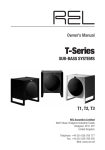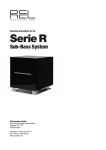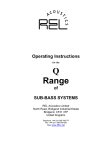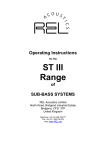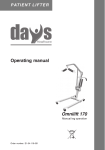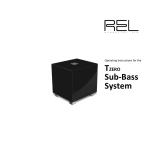Download REL R-Series Manual UK 02/06
Transcript
Owner’s Manual R-Series SUB-BASS SYSTEMS R-205, R-305, R-505 REL Acoustics Limited North Road, Bridgend Industrial Estate Bridgend, CF31 3TP United Kingdom Telephone: +44 (0)1 656 768 777 Fax: +44 (0) 1 656 766 093 Web: www.rel.net Contents Important Safeguards . . . . . . . . . . . . . . . . . . . . . . . . . . . . . . . . . . . . . . . . . . . . .4 Warning . . . . . . . . . . . . . . . . . . . . . . . . . . . . . . . . . . . . . . . . . . . . . . . . . . . . . . .4 Welcome . . . . . . . . . . . . . . . . . . . . . . . . . . . . . . . . . . . . . . . . . . . . . . . . . . . . . .5 World Wide Warranty . . . . . . . . . . . . . . . . . . . . . . . . . . . . . . . . . . . . . . . . . . . . .5 Service After Warranty . . . . . . . . . . . . . . . . . . . . . . . . . . . . . . . . . . . . . . . . . . .5 Design Safety . . . . . . . . . . . . . . . . . . . . . . . . . . . . . . . . . . . . . . . . . . . . . . . . . .6 Important . . . . . . . . . . . . . . . . . . . . . . . . . . . . . . . . . . . . . . . . . . . . . . . . . . . . . .6 Introduction to the R-Series Sub-Bass System . . . . . . . . . . . . . . . . . . . . . . . .7 Control Features of REL R-Series . . . . . . . . . . . . . . . . . . . . . . . . . . . . . . . . . . .8 Disconnecting Wires . . . . . . . . . . . . . . . . . . . . . . . . . . . . . . . . . . . . . . . . . . . . . .9 Connecting Up . . . . . . . . . . . . . . . . . . . . . . . . . . . . . . . . . . . . . . . . . . . . . . . . .10 Neutrik Speakon High Level Input . . . . . . . . . . . . . . . . . . . . . . . . . . . . . . . . . . .10 High Level Interconnect . . . . . . . . . . . . . . . . . . . . . . . . . . . . . . . . . . . . . . . . . . .10 Low Level Input Connection Using Phono to Phono Interconnect . . . . . . . . . . . .11 .1/LFE Input Connection Using Phono to Phono Interconnect . . . . . . . . . . . . . . .11 Phase Switch . . . . . . . . . . . . . . . . . . . . . . . . . . . . . . . . . . . . . . . . . . . . . . . . . .11 REL Set-Up Made Simple . . . . . . . . . . . . . . . . . . . . . . . . . . . . . . . . . . . . . . . .12 Two Things Before You Begin . . . . . . . . . . . . . . . . . . . . . . . . . . . . . . . . . . . . . . .12 Connecting . . . . . . . . . . . . . . . . . . . . . . . . . . . . . . . . . . . . . . . . . . . . . . . . . . . .13 Positioning . . . . . . . . . . . . . . . . . . . . . . . . . . . . . . . . . . . . . . . . . . . . . . . . . . . .13 The Process . . . . . . . . . . . . . . . . . . . . . . . . . . . . . . . . . . . . . . . . . . . . . . . . . . .14 Running In . . . . . . . . . . . . . . . . . . . . . . . . . . . . . . . . . . . . . . . . . . . . . . . . . . . .15 Care and Polishing . . . . . . . . . . . . . . . . . . . . . . . . . . . . . . . . . . . . . . . . . . . . . .16 Technical . . . . . . . . . . . . . . . . . . . . . . . . . . . . . . . . . . . . . . . . . . . . . . . . . . . . .16 Overload Protection . . . . . . . . . . . . . . . . . . . . . . . . . . . . . . . . . . . . . . . . . . . . .16 Power Saving Efficiency . . . . . . . . . . . . . . . . . . . . . . . . . . . . . . . . . . . . . . . . .17 REL R-Series Specifications . . . . . . . . . . . . . . . . . . . . . . . . . . . . . . . . . . . . . .18 REL R-Series Owner’s Manual 3 Important Safeguards 1 Read all of these instructions. 2 Save these instructions for future use. 3 Unplug from the wall socket before cleaning. Do not use liquid cleaners or aerosol cleaners. Use a damp cloth for cleaning. 4 Do not use near water. 5 Do not place on a stand or table; it may fall causing injury to a child or adult, and damage to the unit. 6 The unit should only be operated from the power source indicated on the panel of the amplifier. 7 Only use the power cord supplied. 8 Do not allow anything to rest on the power cord. Position the power cord such that it can not be walked on. 9 For added protection during a lightening storm, or when not in use for long periods of time, unplug it from the wall socket. 10 Never spill any kind of liquid on the unit. 11 Do not attempt to service the unit yourself, as removing the amplifier may expose you to dangerous voltages. Refer all servicing to your dealer. 12 Unplug the unit from the wall socket and refer servicing to your dealer under the following conditions: a When the power cord or plug is damaged. b If liquid has been spilled onto the unit. c If the unit does not operate properly by following the operating instructions. d If the unit has been dropped and damaged. e When the unit exhibits a drastic change in performance. Warning This item is heavy. To avoid risk of injury, take care when handling. 4 REL R-Series Owner’s Manual Welcome Thank you for buying a REL R-Series Sub-Bass System. Our R-Series is carefully hand built using the finest materials available and is designed for maximum performance. This manual contains important safety information as well as helpful advice and should be carefully studied before connecting up. World Wide Warranty In addition to any local warranty, REL offer a 3-year conditional worldwide warranty to the end user. It is done in collaboration with our distributors. The conditions of this warranty are: 1 That REL receive the necessary registration details from the end user. 2 That these details are received within six weeks of purchase. 3 That the product is not exported from the country of purchase for at least eight weeks after purchase. 4 That any claim is accompanied by the necessary proof of purchase. 5 That it shall be for a term of 3 years from the date of purchase. 6 That the product has not been abused or modified in any way. 7 That it was purchased originally from a REL authorized dealer. This warranty is offered in good faith and is in addition to any statuary rights or existing warranty that may be available to the end user. Should your REL Sub-Bass System give you a problem, please contact your dealer who will be able to make whatever arrangements are necessary to correct it. Service After Warranty All service must arranged through a authorized REL dealer. Should the unit need to be returned for any reason, all carriage costs will be payable by the customer. Losses or damage caused during transit are the customer's risk. REL R-Series Owner’s Manual 5 Design Safety This apparatus is designed to Class II specification and is double insulated, therefore it does not require to be earthed. This apparatus is supplied with a fitted mains plug. For North American operation a 3.15 Amp fuse is fitted in the plug. Should the fuse need to be replaced use a similar rated fuse approved to ASTA or BSI 362. Do not use without the fuse cover in place. Replacement fuse covers are available from your distributor. Important The wires in the mains lead are coloured in accordance with the following code: Green and Yellow – Earth Blue – Neutral Brown – Live As the colours of the wires in the mains lead may not correspond with the markings identifying the terminals in the replacement mains plug, proceed as follows: – The wire coloured Green and Yellow must be connected to the terminal marked with the letter "E" or with the earth symbol. – The wire coloured Blue must be connected to the terminal marked with the letter "N". – The wire coloured Brown must be connected to the terminal marked with the letter “L". This product is CE marked and has been tested to ensure it satisfies all relevant standards. It satisfies all relevant standards for Conducted Emissions, Radiated Emissions, Susceptibility and Immunity. It also complies with the requirements relating to class II construction detailed in clauses 9 & 10 of BS EN 60065 1994. It also satisfies all relevant safety tests for consumer use provided it is used within the guidelines of this manual. 6 REL R-Series Owner’s Manual Introduction to the R-Series Sub-Bass System Congratulations, and thank you for purchasing a REL Sub-Bass System, the finest and most innovative audio component in its class. This new R-Series is distinctive not only for its shockingly deep, musical bass, but also for its unique ability to perform as a complement to your main speakers in both music and film applications, as well as a dedicated speaker for the critical low frequency effects (LFE) channel or the .1 in 5.1 track contained in most multi-channel soundtracks. It is for these reasons that we cannot simply call it a subwoofer, but instead a Sub-Bass System, providing home-cinema bass which will surpass most cineplexes, and moreover allowing your speakers to sound more realistic, musical, and alive. We have achieved this objective by allowing for two simultaneous connections: one at high (speaker) level, and one at low level. The high level connection attaches to the same speaker terminals on your amplifier (or receiver) to which your main left and right speakers are connected – the speakers and the REL simply share the same binding posts. This allows the REL to receive the exact same signal as your main speakers, allowing for a seamless integration of the REL into your system. This connection is active every time a signal is going to these speakers, whether you are enjoying 2-channel music or experiencing a multi-channel source such as a DVD or music in a surround-sound format. The result is a surprisingly noticeable improvement to the performance of your speakers – not only will they be supported by a Sub-Bass System capable of reproducing extremely low frequencies, but they will be able to reproduce the nuances of space and weight in the recording, allowing for an enhancement to the imaging, soundstage, midrange, and even high frequency reproduction of your system. Furthermore, a separate but concurrent .1/LFE connection is offered, allowing the REL to receive the LFE track, which is a channel intended by the recording engineer to be exclusively reproduced by a subwoofer. The REL is designed to allow this track to be conveyed in its entirety; the crossover settings designated for the high-level connection are bypassed for the .1/LFE input. Moreover, there is a separate volume control permitting the level to be adjusted independently of the high-level connection. By effectively acting in a dual-role, the REL will significantly add to your music and film experience. To further enhance this effect, additional REL Sub-Bass Systems can be used to support the centre and surround speakers. Imagine the same enhancements to range, detail, and scale achieved by using a REL to support the main left and right speakers expanded to your entire system; by adding REL Sub-Bass Systems to the other speakers you will achieve an enormous and immersive surround sound experience. Due to the novel and powerful capabilities of this product, it is especially important that you read through this manual in its entirety, in order to realize the full potential of the REL and connect it accordingly. REL R-Series Owner’s Manual 7 Control Features of REL R-Series 6. High Level Neutrik Speakon socket 7. Low Level Phono input 8. .1/LFE Phono input 9. Fused IEC AC socket 1. Volume Control for HI/LO input 2. Volume Control for .1/LFE input 3. Variable Crossover Control 4. Phase Switch 5. Power ON/OFF switch 1 2 9 5 8 REL R-Series Owner’s Manual 3 4 6 7 8 Always switch off your system before disconnecting any wires To increase the versatility of connecting up, the R-Series has three separate inputs; a high level Neutrik Speakon socket, a Low Level input socket, and a .1/LFE input socket. As mentioned, this is to facilitate use with both two channel stereo systems and AV surround sound systems. The HIGH LEVEL, dual channel (stereo) input is via a Neutrik Speakon connector which is connected to the power amplifier’s left and right channel speaker terminals. This has the advantage of ensuring that the REL receives exactly the same signal as the main speakers. This means that the character of the bass from the main system is carried forward into the Sub-Bass System. This is a very important point and together with the REL’s Active Bass Controller (ABC), ensures superior system integration of the Sub-Bass System with the main system. The LOW LEVEL input is via a phono connector and connects to the sub or preamp output of the amplifier/processor. This connection exists in the event that the high-level connector can not be used, i.e. if you are using active (self-amplified) speakers without high level speaker terminals. Otherwise it is not the preferred connection method, and should not be used. The .1/LFE input is via a phono connector, and connects to the sub or LFE output of a receiver/processor. This connection is necessary if yours is a multi-channel system, i.e. if you have a multi-channel preamp/processor in your system and you will be playing a source with a .1/LFE channel, e.g. most DVD movies and some SACDs. HIGH LEVEL and .1/LFE inputs can be used simultaneously. The benefits are two-fold when used with a home cinema system. The .1/LFE input reproduces the .1/LFE channel and the high level connection provides sub-bass support for the main front speakers, each input dialed in specific to their function. The main front speakers must be set to the ‘large’ option on the processor. See “REL Set-Up Made Simple”. Only after all connections have been made, can the power switch be activated. REL R-Series Owner’s Manual 9 Connecting Up Connecting the Sub-Bass System using the Neutrik Speakon high level input To engage the Neutrik Speakon plug, insert fully into socket and rotate clockwise until locked. To remove the Neutrik Speakon plug, grip body of plug, place thumb on chrome lever, move lever backwards rotate plug anti-clockwise (or “counter-clockwise”) a quarter turn and withdraw. The HIGH LEVEL input is designed to accept the stereo (two channel) signals from the speaker terminals of your receiver, integrated amplifier, and basic amplifiers. This has the advantage of ensuring that your Sub-Bass System receives exactly the same signal as the main speakers, which means that the character of the bass from the main system is carried forward into the Sub-Bass System. This is a very important point and together with the REL’s ABC circuitry, ensures superior system integration of the Sub-Bass System with the main system. Yellow Black Release Lever HIGH LEVEL INPUT Supplied Neutrik Speakon High Level Interconnect + L Red – + R – Amplifier Main Speaker Outputs High Level connections should be made to the same binding posts as the main speakers Connect as shown above. Red to amplifier main right speaker red terminal, yellow to amplifier main left speaker red terminal and black to amplifier main speaker black terminal, right or left but not both. Plug the Neutrik Speakon plug into the HI LEVEL Neutrik socket. The output level is adjusted using the control marked HI/LO LEVEL 10 REL R-Series Owner’s Manual Low level input connection using phono to phono interconnect (Note: This connection should only be used in the event that the high-level connector can not be used, i.e. if you are using active [self-amplified] speakers without high level speaker terminals, or if crossover control is desired for .1/LFE track reproduction. Otherwise it is not the preferred connection method, and should not be used) LOW LEVEL INPUT Phono Interconnect Preamp Output or Sub/LFE Output Connect as shown above. Plug one end into the Sub/LFE output on the amplifier/ processor and the other end into LOW LEVEL INPUT on the Sub-Bass System. The output level is adjusted using the control marked HI/LO LEVEL .1/LFE input connection using a phono to phono interconnect (Note: This connection is for the .1/LFE channel and should only be used if the REL is being used in a multi-channel system where a .1/LFE signal is present, e.g. with DVDs or SACDs) .1/LFE INPUT Phono Interconnect To Sub/LFE output of Amplifier/Processor Connect as shown above. Plug one end of the interconnect into the Sub/LFE output on the amplifier/processor and the other end into .1/LFE INPUT on the Sub-Bass System. The output level is adjusted using the control marked .1/LFE LEVEL Phase Switch There are two settings accessible via the phase switch: 0 and 180. Follow the procedure detailed below in the section entitled “REL Set-Up Made Simple” to select the appropriate position. REL R-Series Owner’s Manual 11 REL Set-Up Made Simple REL products are not traditional subwoofers, but true Sub-Bass Systems. A REL is designed to augment the performance of “full range” speaker systems, in order to provide, in certain cases, linear response down to below 12 Hz (Studio III, –6 dB down at 9 Hz). Therefore, for the moment, set aside everything you’ve been taught about subwoofers and how they are integrated into a stereo or home cinema system. REL Sub-Bass Systems set-up and positioning differs from conventional subwoofers. A REL will take advantage of physics and room acoustics to provide deep pressurization as no traditional subwoofer can. It’s important that you bring to the set-up process a willingness to do things a little differently in order to obtain these superior results. The end result of your labours will be an utterly seamless integration of true deep bass to a sound system, regardless of the main speakers’ low bass capability. Basic set-up should take no more than ten to fifteen minutes to accomplish once connected. Two Things Before You Begin A It is helpful to know that you will almost always connect the REL to the input on the rear panel labelled “HIGH LEVEL INPUT.” This connection is made using the supplied 34’ 10” (10 meters) cable, the bare leads of which connect to the speaker output terminals of the power amplifier. The easy and foolproof connection at the REL is done with a Neutrik Speakon connector. The purpose of connecting to the speaker output terminals is one of the unique secrets of REL’s success. By connecting to the high level input on the REL from the amplifier, you build forward the sonic signature of your main system, including the tonal balance and timing cues of the entire electronics chain. In this way, the REL is fed the exact signal that is fed to the main speakers. B When possible, the REL should be placed in one of the corners behind the speakers. Remember, we are dealing with true LOW bass pressurization with RELs. Low bass pressurization below 40Hz is best derived from corner placement, where the most linear and efficient low bass can be produced. 12 REL R-Series Owner’s Manual Connecting High-level connection, using the enclosed cable with the Neutrik Speakon connector, is always the first choice. This connection can be made without affecting the performance of the amplifier because the REL’s amplifier input impedance is 100,000 ohms, in effect not producing any additional demand whatsoever on the rest of your system. This scheme also avoids adding any detrimental effects by not interposing any additional electronics into the amplification chain. • The standard high level hook up procedure is: attach the red wire to the amplifier’s right positive speaker output terminal; attach the yellow wire to the amplifier’s left positive speaker output terminal; attach the black wire to whichever of the amplifier’s ground output terminals is convenient; plug the Speakon connector into the Sub-Bass System’s high level input. • For differential (i.e. fully balanced) amplifiers using one REL, simply use the standard connecting scheme with the exception of connecting the black wire to chassis ground (i.e. a metal bolt or screw, preferably not painted or anodized, on the chassis of the power amp or receiver), not to a negative speaker terminal,, and then connecting into the HIGH LEVEL INPUT on the REL. Please contact your dealer should there be any questions concerning this or any other hookup procedure. Low-level connection (via phono connectors) is always an option if high-level connection is not possible. When connecting to the low-level inputs in a system in which high-level connection is not possible, connect a single phono cable to the LOW LEVEL INPUT jack. If you are connecting two channels of stereo output from a pre-amplifier, simply use a high-quality y-adapter to sum the two signals together. When connecting to a home cinema system where there is a .1/LFE channel output, connect a single phono cable between the sub out of the processor/receiver and the .1/LFE input jack on the REL. Positioning The optimal position for a REL is in one of the corners behind the main speakers. This position provides 9 dB of mechanical amplification and allows for the most linear true low bass wave launch, owing to the ability to tune the REL to the longest distance in the room in order to produce the longest, therefore lowest, bass waves. REL R-Series Owner’s Manual 13 The Process To begin the set-up process, choose a piece of music that has a repetitive bass line that is very low in frequency. We recommend track 4 from the soundtrack to Sneakers (Columbia CK 53146). This has a repetitive bass drum throughout that gives you plenty of time to move the woofer around, but more importantly, the recording venue was quite large for this recording, and therefore it has a very deep and large-scale bass signature. This type of track is perfect for the set-up process, and should be played at the highest reasonable level expected for system playback. Working with a partner, one in the listening position and one at the REL manipulating the controls, is the most effective and efficient way to set up the REL. If working alone, the initial steps in the set-up can be very effectively carried out from the location of the REL. Trying to ignore all other music in the track, listen for the bass drum and its effect on the listening room. 1 Phase Orientation: Once in the corner we need to adjust for phase. This may be the single most critical step, and because it really is quite simple, it is often over-thought. Keep in mind; the right phase is whichever position is the loudest or fullest. While playing music with true low bass, adjust the crossover to a point where the REL and the speaker are sure to share frequencies (about halfway up, or at 12 o’clock on the crossover control, or slightly higher for smaller speakers). At this point turn the HI/LO Level control up so that both the REL and speaker are roughly equal in volume and then switch, using the phase switch, from “0” to “180” phase positions. Again, whichever position is loudest or fullest is the correct position. That is, when the position is working in harmony with your main speakers, reinforcing bass, and not cancelling it. 2 Placement: The next step is to determine precisely how far out from the corner the sub should be placed to achieve the most efficient output, as well as the lowest frequency extension. With the REL fully into the corner, and pointing straight out along the diagonal coming out of the corner, continuing to play the music, slowly pull the REL from the corner on the diagonal, equidistant from both side and rear wall. At a certain point (sometimes a matter of only a few inches, in rare cases a foot or more) the REL will audibly go lower, play louder, and, if it truly locks on to the room and is fully pressurizing it, the air around the REL will seem to be energized, stop right there! This is the correct position from the corner for the REL. 3 Orientation: Once the position from the corner has been established, the orientation of the woofer must be determined by rotating the REL from an imagined centre point at the rear of the REL. As the REL is moved from one side to the other listen for the greatest level of output and bass linearity. In effect, the REL should left in the position where it is playing the loudest and lowest. 4 Crossover and Level Settings: To determine the crossover point, take the volume 14 REL R-Series Owner’s Manual of the REL (using the HI/LO Level control) all the way down, and put the crossover to 25 Hz. At this point, bring the REL’s volume back up slowly to the point where you have achieved a subtle balance, i.e. the point at which you can hear the REL even with the main speakers playing. Now, bring the crossover point up until it is obviously too high; at this point bring it down to the appropriate lower setting. For all intents and purposes, this is the correct crossover point. Once this stage has been reached, subtle changes to volume and crossover can be accomplished to provide the last bit of complete and seamless integration. With that, set-up is complete. Hint: There may be a tendency to set the crossover point too high and the volume of the Sub-Bass System too low when first learning how to integrate a REL with the system, the fear being one of overwhelming the main speakers with bass. But in doing so, the resulting set-up will be lacking in bass depth and dynamics. The proper crossover point and volume setting will increase overall dynamics, allow for extended bass frequencies, and improve soundstage properties. Note, volume must be adjusted in conjunction with crossover changes. In general, when selecting a lower crossover point, more volume may need to be applied. Home Cinema Applications: For Dolby Digital AC-3 or other 5.1 theatre systems, once the standard set-up for two-channel outlined above is complete, the LFE output from the processor or receiver should be connected to the .1/LFE INPUT and appropriate volume adjustments made using the .1/LFE level control. For this configuration, you must set the processor to the “large” or “full range” setting for the left and right speakers in order for the REL to receive the bass signal via the high-level cable. In this configuration, the REL provides support for both the left and right speakers for two-channel listening, and support for the LFE when movies are playing. Most processors will allow you to defeat the subwoofer output when listening in the two-channel mode. The effect of this set-up is one of greatly increased dynamics in the mid-bass range, no bass bloat, and a greater degree of space and timing from the special audio effects. For an even greater sense of space and impact, a second REL connected in parallel to the centre channel will prove to be a dramatic improvement as well. And if that is not enough fun, a rear REL, both to support the rear channel speakers as well as to evenly distribute LFE through the room, truly completes the full-range sonic picture for state-of-the-art film reproduction. Running In Care taken over running in will be rewarded by many years of pleasurable use. Both the electronics and the drive unit will benefit from an initial period of carefully controlled use. Possible damage may be sustained by running in the unit at too high a volume setting over an extended period. On the other hand, by taking a little care over this initial period, about 24 hours of actual use, a longer life with a higher potential eventual performance is assured. REL R-Series Owner’s Manual 15 Care and Polishing The cabinets are best maintained by using a spray-on wax, such as an automobile wax made by a company called Griot’s. If objects are to be placed upon the top, it is advisable to use a small mat to protect the surface and to avoid the risk of rattles. Technical The R-Series models use an unusual method of bass loading. They are designed to operate below normal system resonance. This has been achieved without the normal form of bass boost or electronic equalization. Instead of a constantly increasing bass equalization response, we simply ensure there is sufficient amplifier gain to drive the speaker unit to its maximum excursion level at whatever the designated lowest operating frequency is, and then cut the bass at a controlled rate of 12 dB per octave above this frequency. Although this may at first seem identical to boosting the bass, it is actually quite different and ensures that the timing of transients is far improved compared to the usual bass equalization used. Bass will sound cleaner and faster. The amplifier is fully DC coupled to avoid phase shifts and compromises in its low end performance. It is inherently stable and will retain its characteristics over very long periods of time – important in a unit designed for an exceptionally long working life. These amplifiers are designed to withstand reasonable abuse and overloads. If in doubt, please contact your dealer. We believe that the importance of the electronics, cabinet and drivers being designed to work in harmony is paramount. This belief allows the R-205, R-305, and R-505 to achieve the highest possible level of fidelity. Overload Protection All REL Sub-Bass Systems are designed as true sub-bass speakers. They are designed to reproduce those exceptionally deep notes that are felt rather than heard. This it will attempt to do at whatever volume level you set. If set too high no damage should result because the built-in electronics will limit the cone movement. This electronic control is called Set-Safe™. It constantly and instantaneously monitors the output from the power amplifier and is totally transparent in operation until required. This means it has absolutely no effect on the sound quality of your REL until an overload is detected. Ordinarily an overload would cause the power amplifier to go into clipping with resultant loss of control over the drive unit. This can cause drive unit damage, and always sounds nasty. Set-Safe™ detects the point of incipient clipping and gently soft clips the waveform of the signal to ensure actual clipping does not occur. 16 REL R-Series Owner’s Manual This is a necessarily simplified description of what actually happens, but in effect, Set-Safe controls the amplifier and ensures there is minimum risk of amplifier and driver damage caused by over-driving. A thermal overload device is fitted to all R-Series Sub-Bass Systems. If the unit is deliberately overdriven this device will sense the temperature rise and cut the output; recovery time is approximately five minutes. If this happens, it is a warning that the unit is being overdriven and the volume level control should be reduced to a safe level. Although everything possible has been done to minimize risk of thermal overload failure, there can be no defense against those individuals who deliberately abuse the device. Such damage is NOT covered by Warranty. Please remember your REL is there to supplement your main system, not overwhelm it! Power Saving Efficiency All REL Sub-Bass Systems are designed for maximum power efficiency, both when passing a signal through to its resultant output sound into the room and also when silent. REL circuitry is designed for “power starvation” operation under no signal conditions. This means that immediately when there is a gap in the signal the REL is instantly at maximum power saving efficiency, yet remains at maximum readiness to respond immediately to a sudden transient signal, such as an explosion in a movie, even after a long quiet period and regardless of level. This compares to some “auto power on/off systems” which remain powered up for a set period of no-signal condition (up to 10-15 minutes) and which need to power-up on receipt of a sudden transient, thus failing to catch the start of that transient. There is also the possibility of the unit remaining inoperative during listening sessions where the overall volume is low. It is not necessary to switch off between listening sessions – it will not significantly shorten its life by leaving it switched on. On the other hand, it will not harm sound quality if it is always switched off. The power consumption in the quiescent (no signal) state is negligible. REL’s power starvation technology uses less than 4w when idle (less than 1/25th the power of a standard light bulb). It is perfectly safe under all normal domestic circumstances as it is fully protected by internal fuses and an external mains fuse in the fuse holder of the mains input socket, with a spare inside this holder. REL R-Series Owner’s Manual 17 REL R-Series Specifications Model Type Roll Off Input Connectors Amplifier Type Input Impedance High Level Two Channel .1/LFE Level Low Level Input Sensitivity .1/LFE Low Level High Level Drive Unit Power Output Watts Phase Mains Input Volts (Country Specific) Protection Mains Fuses Dimensions WxHxD (Including Feet, Controls & Grille) Net Weight Gross Weight Supplied Accessories Mains Lead Neutrik Speakon Interconnect (High Level) Spikes User Manual 18 REL R-Series Owner’s Manual R-205 Closed box loading 25Hz to 100Hz Neutrik Speakon – High Level Phono – LFE Phono – Low Level Switching Amplifier 150K Ohms 33K Ohms 10K Ohms 40dB 22dB 10” (254 mm) Heavy Duty Long Throw 200 Watts RMS 0 and 180 Degrees 110 Volts or 230 Volts (Depending on country) Over Current, Over Voltage 2.50 Amp semi delay for 230 Volts 3.15 Amp semi delay for 110 Volts 11.5 x 13.25 x 12.5 inches 292.1 X 336.5 X 317.5 mm 30.5 lbs / 13.6 kg 34.8 lbs / 15.8 kg Yes Yes Yes Yes Note: Specifications subject to change without notice R-305 Closed box loading 25Hz to 100Hz Neutrik Speakon – High Level Phono – LFE Phono – Low Level Switching Amplifier R-505 Closed box loading 25Hz to 100Hz Neutrik Speakon – High Level Phono – LFE Phono – Low Level Switching Amplifier 150K Ohms 33K Ohms 10K Ohms 150K Ohms 33K Ohms 10K Ohms 40dB 22dB 10” (254 mm) Heavy Duty Long Throw, Cast 300 Watts RMS 0 and 180 Degrees 110 Volts or 230 Volts (Depending on country) Over Current, Over Voltage 2.50 Amp semi delay for 230 Volts 3.15 Amp semi delay for 110 Volts 12.5 x 14.25 x 13.5 inches 317.5 X 368.3 X 342.9 mm 41 lbs / 18.6 kg 46.4 lbs / 21.1 kg 40dB 22dB 12” (305 mm) Heavy Duty Long Throw, Cast 500 Watts RMS 0 and 180 Degrees 110 Volts or 230 Volts (Depending on country) Over Current, Over Voltage 2.50 Amp semi delay for 230 Volts 3.15 Amp semi delay for 110 Volts 15 x 16.75 x 16.5 inches 381 X 425.4 x 419.1 mm 58 lbs / 26.3 kg 64.7 lbs / 29.4 kg Yes Yes Yes Yes Yes Yes Yes Yes REL R-Series Owner’s Manual 19


















